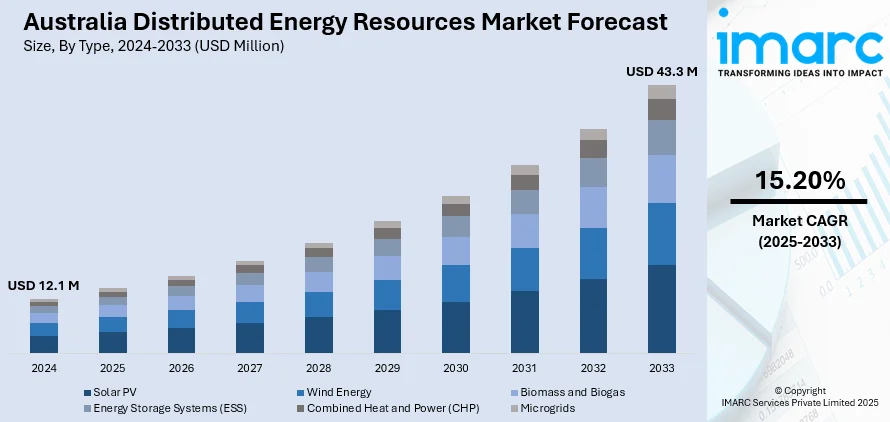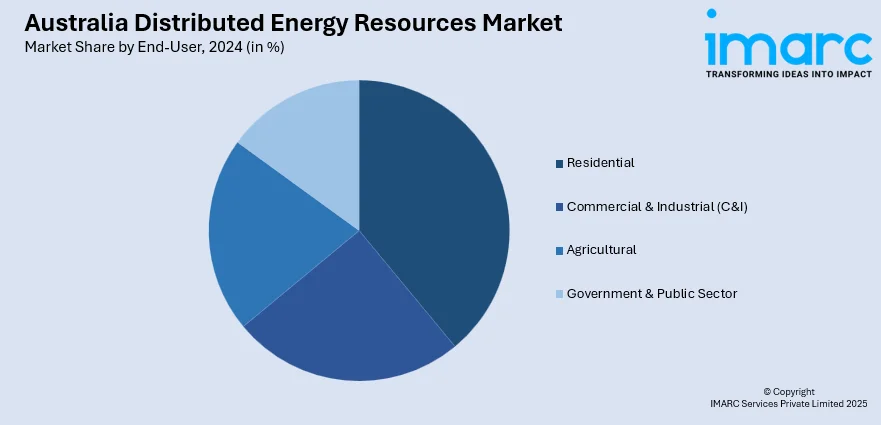
Australia Distributed Energy Resources Market Size, Share, Trends and Forecast by Type, Connectivity, Technology, End-User, and Region, 2025-2033
Australia Distributed Energy Resources Market Overview:
The Australia distributed energy resources market size reached USD 12.1 Million in 2024. Looking forward, IMARC Group expects the market to reach USD 43.3 Million by 2033, exhibiting a growth rate (CAGR) of 15.20% during 2025-2033. Strong uptake of rooftop solar systems, falling battery storage prices, and generous government subsidies and rebate programs are fueling the market growth. Moreover, rising grid electricity costs, increased interest in self-generation and consumption, and the push for decentralized energy models are accelerating the market growth. Furthermore, growing penetration of electric vehicles (EVs), corporate sustainability and net-zero goals, rising frequency of weather-related disruptions, regulatory support for virtual power plants (VPPs), the emergence of smart energy management tools, and increasing participation in community-based energy projects across urban and regional areas are providing a thrust to the Australia distributed energy resources (DER) market share.
|
Report Attribute
|
Key Statistics
|
|---|---|
|
Base Year
|
2024
|
|
Forecast Years
|
2025-2033
|
|
Historical Years
|
2019-2024
|
|
Market Size in 2024
|
USD 12.1 Million |
|
Market Forecast in 2033
|
USD 43.3 Million |
| Market Growth Rate 2025-2033 | 15.20% |
Australia Distributed Energy Resources Market Trends:
High Rooftop Solar Adoption
Australia ranks among the leading nations globally in rooftop solar adoption. By early 2025, more than 4 million households and businesses had installed solar systems, underscoring the widespread acceptance of this technology. A key contributing factor is the country's abundant year-round sunlight, which enhances the efficiency and reliability of solar energy generation. In places like South Australia and Queensland, more than 40% of homes now have rooftop solar, and this percentage continues to grow. Solar systems are becoming cheaper and easier to install, with better financing options and support from certified installers. This has encouraged more middle-income households to make the switch. Rooftop solar not only cuts electricity bills but also reduces pressure on the main power grid by generating electricity right where it’s needed. In 2024 alone, over 3 gigawatts of new rooftop solar capacity were added, showing that demand remains strong, further driving the Australia distributed energy resources market growth.

To get more information on this market, Request Sample
Declining Battery Storage Costs
Declining battery storage costs have significantly enhanced the adoption of distributed energy resources in Australia, enabling more households and small businesses to integrate batteries with their rooftop solar systems. This integration offers substantial benefits, including reduced electricity bills and improved energy resilience during outages. In 2024, Australia witnessed a 30% increase in residential battery installations compared to the previous year, with over 28,000 new units added, bringing the total to more than 121,000 household battery systems nationwide. Government incentives have played a pivotal role in this growth. For instance, South Australia's Home Battery Scheme provides rebates of up to $2,000, while Victoria offers interest-free loans up to $8,800 for solar battery installations. These programs make battery systems more accessible, allowing users to store excess solar energy generated during the day for use in the evening or to feed back into the grid. This capability is particularly valuable in regions prone to frequent power outages or extreme weather events, enhancing household energy security.
Government Incentives and Subsidies
Government support has been instrumental in accelerating the growth of distributed energy resources (DER) in Australia. The federal Small-scale Renewable Energy Scheme (SRES) provides financial incentives for rooftop solar installations, making them more accessible to homeowners. In Victoria, the Solar Homes Program offers rebates for both solar panels and battery storage systems, further reducing upfront costs for families who might otherwise find clean energy systems unaffordable. These initiatives have yielded significant results. As of early 2025, over four million Australian homes have installed rooftop solar systems, contributing to a 20% increase in rooftop solar energy output between December 2024 and February 2025 compared to the previous summer. This surge in adoption not only benefits individual households but also stimulates job creation in clean energy sectors, including system installation, sales, and maintenance
Australia Distributed Energy Resources Market Segmentation:
IMARC Group provides an analysis of the key trends in each segment of the market, along with forecasts at the country and regional levels for 2025-2033. Our report has categorized the market based on type, connectivity, technology, and end-user.
Type Insights:
- Solar PV
- Wind Energy
- Biomass and Biogas
- Energy Storage Systems (ESS)
- Combined Heat and Power (CHP)
- Microgrids
The report has provided a detailed breakup and analysis of the market based on the type. This includes solar PV, wind energy, biomass and biogas, energy storage systems (ESS), combined heat and power (CHP), and microgrids.
Connectivity Insights:
- On-Grid
- Off-Grid
- Hybrid Systems
A detailed breakup and analysis of the market based on the connectivity have also been provided in the report. This includes on-grid, off-grid, and hybrid systems.
Technology Insights:
- Distributed Generation
- Distributed Storage
- Demand Response Technologies
- Smart Grid and IoT Integration
The report has provided a detailed breakup and analysis of the market based on the technology. This includes distributed generation, distributed storage, demand response technologies, and smart grid and IoT integration.
End-User Insights:

- Residential
- Commercial & Industrial (C&I)
- Agricultural
- Government & Public Sector
A detailed breakup and analysis of the market based on the end-user have also been provided in the report. This includes residential, commercial & industrial (C&I), agricultural, and government & public sector.
Regional Insights:
- Australia Capital Territory & New South Wales
- Victoria & Tasmania
- Queensland
- Northern Territory & Southern Australia
- Western Australia
The report has also provided a comprehensive analysis of all the major regional markets, which include Australia Capital Territory & New South Wales, Victoria & Tasmania, Queensland, Northern Territory & Southern Australia, and Western Australia.
Competitive Landscape:
The market research report has also provided a comprehensive analysis of the competitive landscape. Competitive analysis such as market structure, key player positioning, top winning strategies, competitive dashboard, and company evaluation quadrant has been covered in the report. Also, detailed profiles of all major companies have been provided.
Australia Distributed Energy Resources Market News:
- In 2024, Japanese company Inpex, through its stake in Enel Green Power Australia, invested in the Quorn Park Hybrid Project in New South Wales, combining a 98 MW solar farm with a 20 MW/40 MWh battery storage system.
- In 2024, The Australian Renewable Energy Agency (ARENA) committed nearly USD 400 million to renewable energy projects, emphasizing distributed energy resources, to accelerate the nation's transition to net zero emissions.
- In 2023, Western Australia approved the Australian Renewable Energy Hub, a 26 GW wind and solar project aimed at producing green hydrogen and ammonia for export, marking one of the world's largest renewable energy initiatives
Australia Distributed Energy Resources Market Report Coverage:
| Report Features | Details |
|---|---|
| Base Year of the Analysis | 2024 |
| Historical Period | 2019-2024 |
| Forecast Period | 2025-2033 |
| Units | Million USD |
| Scope of the Report |
Exploration of Historical Trends and Market Outlook, Industry Catalysts and Challenges, Segment-Wise Historical and Future Market Assessment:
|
| Types Covered | Solar PV, Wind Energy, Biomass and Biogas, Energy Storage Systems (ESS), Combined Heat and Power (CHP), Microgrids |
| Connectivities Covered | On-Grid, Off-Grid, Hybrid Systems |
| Technologies Covered | Distributed Generation, Distributed Storage, Demand Response Technologies, Smart Grid and IoT Integration |
| End-Users Covered | Residential, Commercial & Industrial (C&I), Agricultural, Government & Public Sector |
| Regions Covered | Australia Capital Territory & New South Wales, Victoria & Tasmania, Queensland, Northern Territory & Southern Australia, Western Australia |
| Customization Scope | 10% Free Customization |
| Post-Sale Analyst Support | 10-12 Weeks |
| Delivery Format | PDF and Excel through Email (We can also provide the editable version of the report in PPT/Word format on special request) |
Key Questions Answered in This Report:
- How has the Australia distributed energy resources market performed so far and how will it perform in the coming years?
- What is the breakup of the Australia distributed energy resources market on the basis of type?
- What is the breakup of the Australia distributed energy resources market on the basis of connectivity?
- What is the breakup of the Australia distributed energy resources market on the basis of technology?
- What is the breakup of the Australia distributed energy resources market on the basis of end-user?
- What is the breakup of the Australia distributed energy resources market on the basis of region?
- What are the various stages in the value chain of the Australia distributed energy resources market?
- What are the key driving factors and challenges in the Australia distributed energy resources market?
- What is the structure of the Australia distributed energy resources market and who are the key players?
- What is the degree of competition in the Australia distributed energy resources market?
Key Benefits for Stakeholders:
- IMARC’s industry report offers a comprehensive quantitative analysis of various market segments, historical and current market trends, market forecasts, and dynamics of the Australia distributed energy resources market from 2019-2033.
- The research report provides the latest information on the market drivers, challenges, and opportunities in the Australia distributed energy resources market.
- Porter's five forces analysis assist stakeholders in assessing the impact of new entrants, competitive rivalry, supplier power, buyer power, and the threat of substitution. It helps stakeholders to analyze the level of competition within the Australia distributed energy resources industry and its attractiveness.
- Competitive landscape allows stakeholders to understand their competitive environment and provides an insight into the current positions of key players in the market.
Need more help?
- Speak to our experienced analysts for insights on the current market scenarios.
- Include additional segments and countries to customize the report as per your requirement.
- Gain an unparalleled competitive advantage in your domain by understanding how to utilize the report and positively impacting your operations and revenue.
- For further assistance, please connect with our analysts.
 Request Customization
Request Customization
 Speak to an Analyst
Speak to an Analyst
 Request Brochure
Request Brochure
 Inquire Before Buying
Inquire Before Buying




.webp)




.webp)












